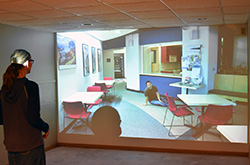While the students are certainly real, the circumstances and individuals they encounter are interactive scenarios delivered through the College’s MILO Range simulator. The software package projects real-life scenarios, performed by actors, on a wall inside the College’s Law and Public Safety Training Lab.
Northeast is currently the only college in Nebraska with a MILO simulator.
Matt McCarthy, criminal justice director, explained how the simulator works. When students interact with the subjects projected on the wall, the instructor, who uses the MILO software on a dedicated laptop, evaluates the student’s performance and chooses how the situation will unfold.
“So if the student is standing there not doing anything or isn’t responsive, then I can increase the violence level or tension of the scenario. So it could go from somebody yelling at you to somebody throwing a punch at you to somebody possibly using a weapon. But if the student is talking effectively, they’re interacting with the subject and they’re speaking intelligently, then I can choose another end to the scenario where it de-escalates, where the subject says, ‘Ok, I appreciate you listening to me,’ and then they leave.”
McCarthy said the MILO simulator is used in a number of classes at Northeast, including Communication Skills in Criminal Justice, Introduction to Forensic Crime Scene Investigation, Police and Society, and others.
“It crosses the whole criminal justice realm.”
Northeast student Emily Sojka, Norfolk, plans to pursue forensic science as a career, and said the MILO simulator can even be beneficial to someone like her, who will primarily work in a laboratory setting.
“If I have to go to court and testify in a case, it would be helpful there. If I was out in the field collecting evidence at a scene, and someone who knew the victim drove up and started to get emotional because they didn’t know what happened, my experience with the MILO simulator could help me calm people down in those situations, too.”
Sojka said that even though the simulator initially made her feel “a bit nervous,” she knew the experience was essential to her training.
“You have to think on your feet a little bit. So when you start the scenario, you have to gauge what’s going on, try to talk to the person. If they’re irate, they might not want to talk to you or communicate clearly, so you have to piece together the information in your mind as you continue to try to talk to them. You have to get used to people yelling and all the commotion.”
Northeast purchased the MILO simulator in 2017. McCarthy said the software was used in a limited capacity through the 2017-18 academic year and was permanently installed in the Law and Public Safety Training Lab in August 2018.
Before that, McCarthy said students had minimal opportunity to practice their communication skills in realistic scenarios.
“We really had no way of exposing them to the stress (of these situations). We had done a couple exercises where they would knock on a door and talk to somebody, just taking a report of a crime, but nothing stressful. MILO gives us the ability to do that.”
McCarthy said several agencies, including the Madison County Sheriff’s department, also use Northeast’s MILO simulator, which can grade officers on their shooting, the timing of their shots and other factors.
“You’ll hear people sometimes refer to MILO as a shooting simulator, and it certainly has that capability. But we use it as a use-of-force simulator in our classes at Northeast. Because our goal here is not to teach the students to be marksmen. That’s what police officers use it for.”
McCarthy said an enhanced version of the MILO simulator also allows users to record their own interactive scenarios. He envisions the College’s theatre and digital cinema programs working to create custom scenarios that can be set on campus and feature student actors. These custom scenarios could potentially be used to train Northeast employees to interact with students in tense situations, or by law enforcement to conduct emergency drills in campus buildings.
“The ways we can use the MILO simulator with the next step up are really limitless,” McCarthy said. “And it doesn’t have to involve shooting. And in the perfect world, it never would.”
For more information about the Northeast Community College criminal justice program, contact McCarthy at (402) 844-7345.
This activity was partially funded with federal Carl D. Perkins Career and Technical Education Act of 2006 funds administered through the Nebraska Department of Education, grant number V048A160027.
--###--
PHOTO CUTLINE
Emily Sojka, Norfolk, a student in the criminal justice program at Northeast Community College, communicates with an individual experiencing a medical episode as part of a training scenario using the College’s MILO Range simulator. Northeast is currently the only college in Nebraska with a MILO simulator.

